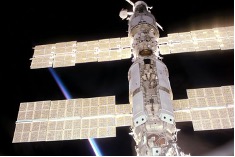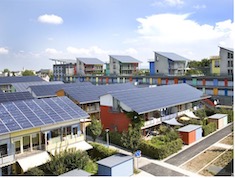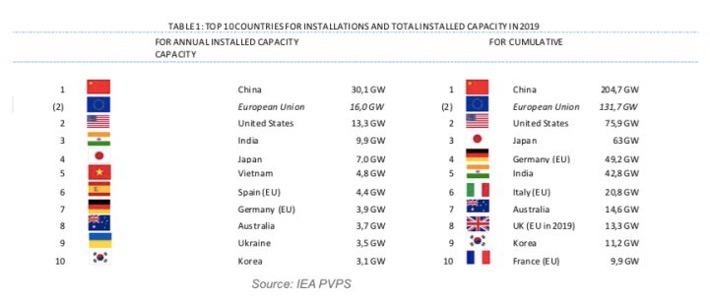In 1954, Bell Laboratories produced a photovoltaic cell with an efficiency of 6%. Since 1958, the photovoltaic effect has been applied for the first time in the field of energy supply for space satellites in the form of photovoltaic cells. Today, the application of power generation in the field of power generation has spread all over the world, ranging from the energy supply of automatic parking meters and rooftop solar panels to large-scale solar power generation centers. Its application in the field of power generation has spread all over the world.

Solar panels on the International Space Station

Roof solar panels
After hydropower and wind power, photovoltaic power generation is the third largest renewable energy source in terms of installed capacity worldwide. The International Energy Agency predicts that in the mid-2020s, photovoltaic power generation may become the renewable energy with the largest installed capacity. Today, the editor will lead you to know the top ten largest photovoltaic power plants in the world.
NO.10 Villanueva solar power plants
The Villanueva solar power plant is located in the town of Huesca, Coahuila, Mexico. The power station is the largest solar project in Latin America, covering an area of 15 square kilometers, equivalent to the size of 2,200 football fields.
Villanueva solar power plants, with a rated capacity of 828 megawatts and a total investment of 710 million US dollars, use a total of 2.3 million solar panels, which can provide enough electricity to power 1.3 million households.
NO.9 Longyangxia Solar Power Station
The Longyangxia Solar Power Station is located near the mainstream of the Yellow River at the junction of Gonghe County and Guinan County, Qinghai Province, China, and is close to the Longyangxia Dam. In 2013, the first phase of the Longyangxia Solar Power Plant was completed, with a rated capacity of 320 MW and an area of 9 square kilometers. In 2015, the second phase of the project was completed, with a rated capacity of 530 MW, covering an area of 14 square kilometers, and the total capacity of the Longyangxia Dam Solar Power Station is 850 MW. The solar power plant is integrated with the hydroelectric power plant. The power station is connected to one of the hydroelectric turbines, which automatically adjusts output to balance the variable generation from solar before distributing power to the grid.
NO.8 Ananthapuram solar power plants
Ananthapuram solar power plant is located in Ananthapura, Andhra Pradesh, India, covering an area of 32 square kilometers.
The first phase of the Ananthapuram solar power plant with a capacity of 900 MW was put into use on May 9, 2016 with a capacity of 200 MW. The current capacity is 900 MW, and the total planned capacity is 1500 MW.
NO.7 Datong Solar Leader Base
Datong Solar Leader Base is located in the coal mining subsidence area of Datong City, Shanxi Province, China. Datong Solar Leader Base started construction in September 2015. It is divided into 13 construction projects with a total installed capacity of 1,000 MW, and all of them will be connected to the grid before June 30, 2016. According to statistics, during the seven months from July 2016 to January 2017, the Datong Solar Leader Base generated a total of 870 million kilowatt-hours of electricity, which is equivalent to generating more than 120 million kilowatt-hours per month.
NO.6 Kurnool solar power station
The capacity of the Kurnool solar power plant is located in the villages of Gani and Sakunala in the Kanur district of Andhra Pradesh, India, covering an area of 24 square kilometers. The Kurnool solar power plant has a capacity of 1,000 megawatts. Bidding began in April 2015, and power generation began in July 2017. The total cost is 5.94 billion RMB. To deal with the shortage of water resources, all of the need for the park's water, including water for cleaning solar panels and water supply can be met through reservoirs built for rainwater collection.
NO.5 Noor Abu Dhabi solar power plant
The Noor Abu Dhabi solar power project is developed on 780 hectares of land in the eastern region of the emirate of Abu Dhabi. It is located about 120 kilometers away from the east of Abu Dhabi. The Noor Abu Dhabi solar power station has a total capacity of 1,177 MW. Construction of the project began in May 2017 and commercial operation began in April 2019. Costing 6.23 billion RMB, the Noor Abu Dhabi power station's 3.2 million panels can provide enough electricity for 90,000 people and will reduce carbon dioxide emissions by 1 million metric tons (984,206 tons).
NO.4 Benban solar power station
Benban Solar Power Station is located in Benban, Aswan Province, Egypt, which is a desert, about 650 kilometers south of Cairo and 40 kilometers northwest of Aswan. Benban photovoltaic power plant, with a total capacity of 1,650 megawatts, is the first large-scale photovoltaic power plant in Egypt and is currently the fourth largest solar power plant in the world. Construction of the power station started in February 2018 and was completed in November 2019. The power station covers an area of 37.2 square kilometers and cost 4 billion US dollars.
NO.3 Ningxia Tenggeli Solar Power Station
Ningxia Tenggeli Solar Power Station is located in the Tenggeli Desert in Ningxia, covering an area of 43 square kilometers.
Tenggeli Solar Power Station has a capacity of 1547 MW. In addition, it also combines photovoltaics with desert control and water-saving agriculture, creating a successful precedent for photovoltaic grid-connected power stations in deserts across the country and the world. In order to save land, lycium chinensis are planted under the photovoltaic panels to increase economic income and help the poorer.
NO.2 Pavagada Solar Power Station
The Pavagada Solar Power Station is located in the Pavagada region of Karnataka, India. The region is located in a semi-arid region with little rainfall, high solar radiation, a sparse population and an abundant supply of land. The Pavagada Solar Power Station covers an area of 53 square kilometers. The power station was completed in 2019 at a cost of 2.1 billion U.S. dollars and has a capacity of 2,050 megawatts. It is the second largest photovoltaic power station in the world after the 2,245 MW Badra Solar Park.
No.1 Bhadla Solar Power Station
The Bhadla solar power station is located in the Bhadla area of Jodhpur County, Rajasthan, India, which is sandy, dry, and arid. Badra's average temperatures are between 46 and 48 degrees Celsius, with frequent hot winds and sandstorms. The Badra Solar Power Station is the largest solar power station in the world, covering an area of 40km2, and the total rated capacity of the station is 2245 MW. The power station was completed in March 2019.
If you talk about the country with the largest photovoltaic power generation capacity in the world, it is of course China. Finally, the ranking of the top ten countries in the world for solar photovoltaic installations in 2019 is as follows:
